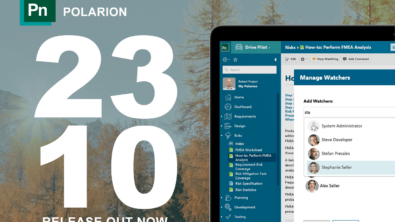Kanban the Polarion Way (Part 2) – Using Polarion with Kanban
In this second of a 2-part series, I will show you how Polarion’s Tier 3 support uses Polarion with Kanban in conjunction with our Polarion ALM system to effectively managehard-to-predict team workloads.
Polarion as Kanban board
Visualisation of the workflow
The usual way to visualise the workflow is with a “Kanban board”. Naturally we have used Polarion, because all of the data is already there. Implementations usually vary in what is visualised on the board, it is either workflow of user stories (high-level entities) or workflow of tasks (low-level entities). Naturally by the process of incremental, evolutionary change we have ended up with two separate boards. This is how our story board looks (click on images to enlarge them):
And this is the task board. Notice the nice table which is part of a new Easy Planning feature released with Polarion 2014:
Our story board is also in a physical form, while the task board is only inside Polarion. Our ultimate goal is to merge the two boards into one while retaining the information properties of both of them.
Work-in-Progress limit
Main reason we have two boards is the way we enforce Work-in-Progress limits. Kanban is pull system (team members pull work from a queue), but our current workflow is not fully pull-compliant and sometimes it may happen that work is pushed onto people. So we just monitor the number of items in almost all states and show warning if the limit is exceeded.
Metrics
Great many metrics can be used. We have settled with three of them:
- Cumulative Flow Diagram
- Control Chart
- Cluster Analysis
Cumulative Flow Diagram
The Cumulative Flow Diagram visualises number of items on the storyboard over time. You can easily spot the difference between healthy and unhealthy process as healthy process is smooth, while unhealthy is very bumpy (the one we are showing here does not look healthy, but when we started using new Planning feature of Polarion 2014 we had to reset the data and now it is still too early to tell).
Control Chart
Control Chart for Cycle Time shows the time it took every item to go from development to verification. We have also statistical table with which we are able to predict with certain probability the time it will take us to produce a patch, for example:
The integration of the powerful Highcharts library with Polarion 2013-SR3 allowed us to go even further, as we are able to show the changes in the cycle time on the chart itself and thus be able to validate the changes in the process (we do it already, but it is much easier if plotted on the chart).
Cluster Analysis
Cluster Analysis for Cycle Time shows the same data as Control Chart, but shows clearly how dispersed are individual types of items.
Conclusion
Polarion is and has always been Kanban compatible. It was just a bit more complicated to actually visualise the workflow and produce some metrics to give feedback to the team and to the process itself, but it was possible nevertheless. With recent Polarion versions (new charts, new Planning feature) it is becoming easier and we are looking into ways how to make it as easy as possible for our customers.
ABOUT THE AUTHOR: Stepan Roh is a senior software engineer with Polarion Software R&D, and leader of the Tier 3 support team.
Photo: Flickr/Alan Stark









